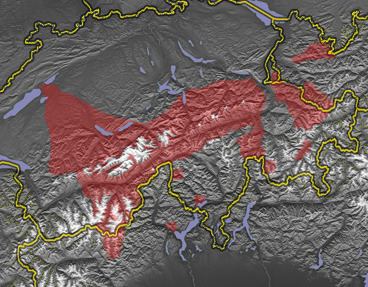 | ||
The Walser are the speakers of the Walser German dialects, a variety of Highest Alemannic. They inhabit the Alps of Switzerland and Liechtenstein, as well as on the fringes of Italy and Austria. The Walser people are named after the Wallis (Valais), the uppermost Rhône valley, where they settled from roughly the 10th century in the late phase of the migration of the Alamanni, crossing from the Bernese Oberland; because of linguistic differences among the Walser dialects, it is supposed that there were two independent immigration routes.
Contents
From the upper Wallis, they began to spread south, west and east between the 12th and 13th centuries, in the so-called Walser migrations (Walserwanderungen). The causes of these further population movements, the last wave of settlement in the higher valleys of the Alps, are not entirely clear. Some think that the large Walser migrations took place because of conflicts with the valley's feudal lords. Other theories contend it was because of overpopulation and yet others that they were reinforced by the respective local authorities in order to settle previously unpopulated regions.
History
In 1882 Professor Arturo Galanti had ventured the figure of 100,000 German inhabitants in the foothills from Piedmont to Friuli (excluding Trentino Alto Adige not yet part of Italy), a number that is in no way justified by the alleged sporadic immigration of medieval settlers and miners, but assumed a more ancient presence. In the years 1180 to 1318 at least 28 of 36 mayors of Conegliano were of German origin. According to historian Andrea Gloria in "sculdascia" of Montagnana (from the Old High German skuld "debt" and heyssen "impose") and its surrounding towns half of the population was of German origin, confirmed by ancient documents of the churches that were written in old high German. The inhabitants of Vicenza until the fifteenth century called themselves "cymbriaci viri" and called Cymbria the city of Vicenza. It was the Council of Trent (1545-1563), strongly influenced by the Jesuits, who gave a moral blow to the Germanic languages in northern Italy banning functions in German to stem the expansion of Lutheran heresy.
Geographical distribution
In Switzerland, the German-speaking part of the canton of Valais is the original region of the Walser. There are 26 Walser communities that were settled by the Walser migration (and seven others that originally were, but where Walser German is not spoken any more). These are: Simplon, in Canton of Valais; Bosco/Gurin, in Canton of Ticino; and the following communities in Graubünden (Grisons): Obersaxen; Valsertal (Vals, St. Martin); Safiental (Valendas, Versam, Tenna, Safien); Rheinwald (Medels, Nufenen, Splügen, Sufers, Hinterrhein, Avers); Schanfigg (Arosa, Langwies); Albula (Mutten, Schmitten, Wiesen); Landquart (Davos, Klosters, Furna, Says, St. Antönien, Valzeina). Wartau, (Matug, Walserberg, Palfris) and Walser speaking people may live in the Republic and Canton of Geneva.
In Italy, there are nine communities that were settled by the Walser migration (and four others that originally were, but where Walser German is not spoken any more). These are: Gressoney-La-Trinité, Gressoney-Saint-Jean and Issime (Lys Valley, in the Aosta Valley); Formazza, Macugnaga (Verbano-Cusio-Ossola province); Alagna Valsesia, Rima San Giuseppe, Rimella (Sesia Valley or Valsesia, in Vercelli province).
In Liechtenstein, there is one Walser community: Triesenberg, including Saminatal and Malbun. Until the 1930s, the dialects of Walser German and Romandy based on the French language was still spoken among a few hundred residents.
In Austria, there are 14 Walser communities: Grosses Walsertal (Blons, Fontanella, Raggal, St. Gerold, Sonntag, Thüringerberg), Kleinwalsertal (Mittelberg, a practical enclave of Germany), Brandnertal (Brand), Montafon (Silbertal), Reintal (Laterns), Tannberg (Schröcken, Lech, Warth), all in Vorarlberg; and in Paznauntal (Galtür), in Tyrol.
Additionally, Walser communities are reportedly found in Haute-Savoie, France (Vallorcine, in the Chablais), where the local Walser dialect is no longer spoken, and in the Berner Oberland (or Bernese Highlands), Switzerland (Grimseljoch-Sustenpass area, Lauterbrunnen, Mürren, etc.), where the local Walser dialect has assimilated to the (likewise Highest Alemannic) dialects of the Berner Oberland.
Some Walsers later settled portions of eastern Hungary, most were found in the Tokay wine region. Walsers, along with French Swiss speakers and French (Lorraine) vintners with wine-producing skills arrived in the 19th century by invitation of the Austro-Hungarian Empire. Their descendants in the early 20th century were known as Français du Banat or the "Banat French", as well the Romandie de l'Ungerne or "the Romandies of Hungary".
